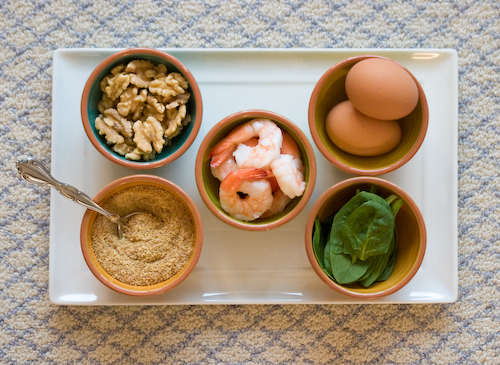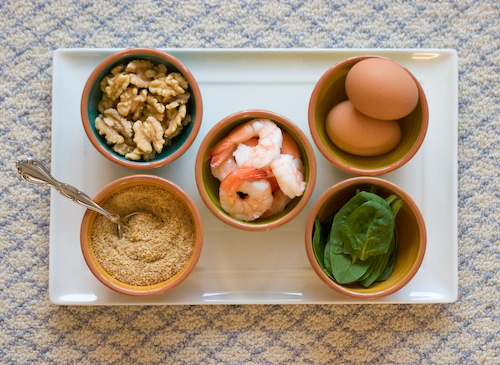Omega-3 Carrot Cake

The Fats of Life
One step in America’s return to healthful living is to see dietary fat as good. Natural fats were so excoriated in the last half-century that any processed food with a “low-fat” claim was considered healthful. This is crazy, but a society learns slowly, and changes food behavior even more slowly; it can take a generation for each step. There is one shining light exception: the readers of Word of Wisdom Living. If you actively apply the 52 Healthy Changes according to your needs; you can change in a year. In food culture, that’s like turning on a dime.
Omega-3 fats are mainly found in green plants; omega-6 fats are found in the seeds. When people lived on the food at hand, they got lots of omega-3 in the spring and summer and more omega-6 in the fall and winter. In fact, foods rich in omega-3, like greens, have a short shelf life. Most omega-6 seeds can last for years if properly stored. Because processed foods need a long shelf-life, omega-3 fats were removed from the American diet.
The 1000-Mile Cornfield
I had a wonderful adventure a few years ago with our first son. He and his wife had finished law school and were moving to Washington, D.C. They loaded their possessions into a big truck with a trailer attached for their car, and the son and I made the cross-country drive. The length of the truck with trailer made turning around hard so we tried to avoid dead ends. Once, in a small town in Tennessee, just about bedtime, we got stuck in a narrowing street. The people may have thought that we were moving into their neighborhood because everyone came out to help. Dads were making suggestions, excited kids were running around our big noisy truck, and dogs were barking. The solution required waking up a lady to move her car out of the way. I learned something about extraordinary kindness of people on that trip. We also learned what’s between Colorado and, say, Tennessee: corn. We drove through a thousand miles of non-stop corn.
Now I can see the 1000 miles of corn as a metaphor for the rise of omega-6 and decline of omega-3 in the American diet. Corn products are high in omega-6; the leaves, which are made into animal feed, contain omega-3. Here are some consequences, from animal studies:
- Scientists at Wake Forest found that eating more omega-6 fat increases the build up of plaque in coronary arteries, while omega-3 reduces plaque accumulation.
- Researchers at the Bassett Research Institute found it easy to grow cancer tumors when animals were fed an omega-6 diet (from corn oil) but almost impossible with omega-3 rich fish oil.
- In Australia studies show that omega-3 speeds up the metabolic rate, the speed at which we burn calories, while omega-6 slows it down. Want to be more active and burn off that extra fat? Eat more greens and less of the processed seeds.
Heart Disease
Susan Allport wrote a great book with a descriptive title: The Queen of Fats: Why Omega-3s Were Removed from the Western Diet and What We Can Do to Replace Them. If you want to understand the essential fats better, get this book. The key discoveries about omega-3 fats are so recent many of the scientists are still alive, including Dr. Ralph Holman, now in his 90s.
Allport tells about a man in Dr. Holman’s lab who was dying of heart disease. The man had a prior coronary artery replacement surgery but his arteries were now so clogged with plaque that another was needed. Unfortunately he wasn’t healthy enough to attempt the surgery. Holman suggested a diet high in omega-3 fats, in addition to the customary medical care and begin to bring by his homemade flaxseed cakes. The patient made a remarkable recovery and lived another 20 years.
Now this was just one person and you can’t draw too big a conclusion from an anecdotal experience. But if I were suffering from heart disease, I’d discuss my omega-6/-3 status with a qualified doctor and give serious attention to his, or her, recommendations. Ms. Allport offers recipes that include more omega-3 here. And Dr. Holman inspired me that we should have a healthy cake on our recipe list.
Dr. Holman's Flaxseed Cake
I looked over Dr. Holman’s Flaxseed Cake recipe with the idea to improve it. This brought to mind a recent article in Cooks Illustrated on carrot cake. I considered ingredients rich in omega-3 fats: eggs, fresh walnuts, flaxseed, Canola oil, and butter which though mostly saturated fat, has a healthful ratio of omega-6/-3. I also reviewed online recipes. Most carrot cake recipes call for pecans but we choose walnuts for their omega-3 content. We used the best available oil—Spectrum’s expeller pressed, Organic High Heat Canola Oil; it’s a bit more costly but less than EVOO, so seemed a good omega-3 value. Organic means non-GMO.
Some carrot cake recipes include crushed pineapple and others add raisins. In our tests these ingredients improved the flavor and reduced the need for sugar. We used 1½ cups of sugar instead of the typical 2 cups; we also reduced the amount of frosting by half. Our first batches had a nasty aftertaste that we traced to stale nutmeg and cloves. Suggestion: Check your spices for bitter aftertaste before using. Because our spices weren’t that old (a year or so) I’m starting to think grinding nutmeg and cloves fresh is the way to go. We’re probably like most people; it takes several years to use even a small container of these spices.
Skip’s Omega-3 Carrot Cake
Cake Ingredients:
1 cup whole-wheat flour, fresh ground (we have a hand grinder, good exercise)
1 cup flaxseed meal, fresh ground (we use a Cuisineart spice and nut grinder, a bargain at $40)
1½ cup sugar, either browns or turbinado
1½ tsp cinnamon (or 2 tsp if you don’t have fresh ground cloves and nutmeg)
¼ tsp nutmeg, ground
¼ tsp cloves, ground
2 tsp baking soda
1 tsp baking powder
½ tsp salt
1 cup cold-pressed organic canola oil
3 or 4 eggs (we prefer omega enhanced eggs)
1 tsp vanilla
3 cup carrots, grated (about 4 carrots)
8 oz crushed pineapple (with natural juice)
1 cup raisins
1 ½ cup walnuts, chopped (more is OK with me)
Frosting Ingredients (this is half the normal recipe)
4 oz cream cheese, softened
¼ cup butter, softened
½ tsp vanilla
2 cups powdered sugar, sifted (unsifted made small lumps)
Directions:
Mix dry and wet ingredients and combine. Pour into 9” x 13” prepared pan. Bake at 350 F about 30 minutes, until done. When cooled, apply frosting. Pretty simple. This cake is so moist and tasty you can even eat it without frosting.
Please comment: How to you add omega-3 fats to your diet. Have a favorite healthy dessert? Please share it.
 Friday, April 13, 2012 at 3:09PM | by
Friday, April 13, 2012 at 3:09PM | by  Skip Hellewell |
Skip Hellewell |  5 Comments | | in
5 Comments | | in  fats 101,
fats 101,  recipe |
recipe |  Email Article
Email Article 

















